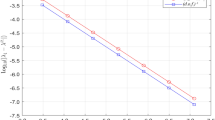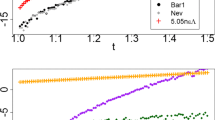Abstract
We present a fast algorithm that constructs a data-sparse approximation of matrices arising in the context of integral equation methods for elliptic partial differential equations. The new algorithm uses Green’s representation formula in combination with quadrature to obtain a first approximation of the kernel function, and then applies nested cross approximation to obtain a more efficient representation. The resulting \({\mathcal H}^2\)-matrix representation requires \({\mathcal O}(n k)\) units of storage for an \(n\times n\) matrix, where k depends on the prescribed accuracy.





Similar content being viewed by others

References
Anderson, C.R.: An implementation of the fast multipole method without multipoles. SIAM J. Sci. Stat. Comput. 13, 923–947 (1992)
Bebendorf, M.: Approximation of boundary element matrices. Numer. Math. 86(4), 565–589 (2000)
Bebendorf, M., Grzhibovskis, R.: Accelerating Galerkin BEM for linear elasticity using adaptive cross approximation. Math. Meth. Appl. Sci. 29, 1721–1747 (2006)
Bebendorf, M., Rjasanow, S.: Adaptive low-rank approximation of collocation matrices. Computing 70(1), 1–24 (2003)
Bebendorf, M., Venn, R.: Constructing nested bases approximations from the entries of non-local operators. Numer. Math. 121(4), 609–635 (2012)
Börm, S.: Efficient numerical methods for non-local operators: \({\cal {H}}^2\)-matrix compression, algorithms and analysis. EMS Tracts Math. 14, (2010). doi:10.4171/091
Börm, S., Gördes, J.: Low-rank approximation of integral operators by using the Green formula and quadrature. Numer. Algorithms 64(3), 567–592 (2013). doi:10.1007/s11075-012-9679-2
Börm, S., Grasedyck, L.: Hybrid cross approximation of integral operators. Numer. Math. 101, 221–249 (2005). doi:10.1007/s00211-005-0618-1
Börm, S., Grasedyck, L., Hackbusch, W.: Hierarchical Matrices. Lecture Note 21 of the Max Planck Institute for Mathematics in the Sciences (2003)
Börm, S., Hackbusch, W.: Data-sparse approximation by adaptive \({\cal {H}}^2\)-matrices. Computing 69, 1–35 (2002). doi:10.1007/s00607-002-1450-4
Börm, S., Hackbusch, W.: \({\cal {H}}^2\)-matrix approximation of integral operators by interpolation. Appl. Numer. Math. 43, 129–143 (2002)
Brandt, A.: Multilevel computations of integral transforms and particle interactions with oscillatory kernels. Comput. Phys. Commun. 65(1–3), 24–38 (1991)
Brandt, A., Lubrecht, A.A.: Multilevel matrix multiplication and fast solution of integral equations. J. Comput. Phys. 90, 348–370 (1990)
Dahmen, W., Prössdorf, S., Schneider, R.: Wavelet approximation methods for pseudodifferential equations I: stability and convergence. Math. Z. 215, 583–620 (1994)
Dahmen, W., Schneider, R.: Wavelets on manifolds I: construction and domain decomposition. SIAM J. Math. Anal. 31, 184–230 (1999)
Giebermann, K.: Multilevel approximation of boundary integral operators. Computing 67, 183–207 (2001)
Goreinov, S.A., Tyrtyshnikov, E.E., Zamarashkin, N.L.: A theory of pseudoskeleton approximations. Linear Algebra Appl. 261, 1–22 (1997)
Grasedyck, L., Hackbusch, W.: Construction and arithmetics of \({\cal {H}}\)-matrices. Computing 70, 295–334 (2003)
Greengard, L., Rokhlin, V.: A fast algorithm for particle simulations. J. Comput. Phys. 73, 325–348 (1987)
Hackbusch, W.: Elliptic Differential Equations. Theory and Numerical Treatment. Springer-Verlag, Berlin (1992)
Hackbusch, W.: A sparse matrix arithmetic based on \({\cal {H}}\)-matrices. Part I: introduction to \({\cal {H}}\)-matrices. Computing 62, 89–108 (1999)
Hackbusch, W.: Hierarchische Matrizen: Algorithmen und Analysis. Springer, New York (2009)
Hackbusch, W., Khoromskij, B.N.: A sparse matrix arithmetic based on \({\cal {H}}\)-matrices. Part II: application to multi-dimensional problems. Computing 64, 21–47 (2000)
Hackbusch, W., Nowak, Z.P.: On the fast matrix multiplication in the boundary element method by panel clustering. Numer. Math. 54, 463–491 (1989)
Harbrecht, H., Schneider, R.: Wavelet Galerkin schemes for boundary integral equations: implementation and quadrature. SIAM J. Sci. Comput. 27, 1347–1370 (2006)
Hsiao, G.C., Wendland, W.L.: Boundary Integral Equations. No. 164 in Appl. Math. Sci. Springer, New York (2008)
Maaskant, R., Mittra, R., Tijhuis, A.: Fast analysis of large antenna arrays using the characteristic basis function method and the adaptive cross approximation algorithm. IEEE Trans. Antennas Propag. 56(11), 3440–3451 (2008)
Rokhlin, V.: Rapid solution of integral equations of classical potential theory. J. Comput. Phys. 60, 187–207 (1985)
Sauter, S.A.: Cubature techniques for 3-d Galerkin BEM. In: Hackbusch, W., Wittum, G. (eds.) Boundary Elements: Implementation and Analysis of Advanced Algorithms, pp. 29–44. Vieweg-Verlag, Berlin (1996)
Sauter, S.A., Schwab, C.: Randelementmethoden. Teubner, Berlin (2004)
Schöberl, J.: NETGEN: an advancing front 2D/3D-mesh generator based on abstract rules. Comput. Vis. Sci. 1(1), 41–52 (1997)
Tamayo, J.M., Heldring, A., Rius, J.M.: Multilevel adaptive cross approximation. IEEE Trans. Antennas Propag. 59(12), 4600–4608 (2011)
Tyrtyshnikov, E.E.: Mosaic-skeleton approximation. Calcolo 33, 47–57 (1996)
Tyrtyshnikov, E.E.: Incomplete cross approximation in the mosaic-skeleton method. Computing 64, 367–380 (2000)
Ying, L., Biros, G., Zorin, D.: A kernel-independent adaptive fast multipole algorithm in two and three dimensions. J. Comput. Phys. 196(2), 591–626 (2004)
Author information
Authors and Affiliations
Corresponding author
Additional information
Part of this research was funded by DFG Grant BO 3289/2-1.
Appendix A: Proofs of technical lemmas
Appendix A: Proofs of technical lemmas
Proof of Lemma 3
By definition of the maximum norm, we can find \(\iota \in \{1,\ldots ,d\}\) such that \(2\delta _t = \mathop {\mathrm{diam}}\nolimits _\infty ({\mathcal B}_t) = b_{t,\iota }-a_{t,\iota }\) and \(b_{t,\kappa }-a_{t,\kappa }\le 2\delta _t\) holds for all \(\kappa \in \{1,\ldots ,d\}\). Most of our claims are direct consequences of this estimate, only the last claim of (16) requires a closer look. Let \(x\in \partial \omega _t\) and \(y\in {\mathcal F}_t\) be given with
Let \(\widehat{x}\in {\mathcal B}_t\) be a point in \({\mathcal B}_t\) that has minimal distance to x. By construction, we have
and the triangle inequality in combination with (5) yields
and this is the required estimate. \(\square \)
Proof of Lemma 4
Let \(\kappa \in {\mathbb {N}}_0^d\) be a multiindex. We consider the function
and aim to prove
with the vector
We proceed by induction: for the multiindex \(\nu =0\), the identity (31) is trivial.
Let \(m\in {\mathbb {N}}_0\) and assume that (31) has been proven for all multiindices \(\nu \in {\mathbb {N}}_0^d\) with \(|\nu |\le m\). Let \(\nu \in {\mathbb {N}}_0^d\) be a multiindex with \(|\nu |=m+1\). Then we can find \(\mu \in {\mathbb {N}}_0^d\) with \(|\mu |=m\) and \(i\in \{1,\ldots ,d\}\) such that \(\nu =(\mu _1,\ldots ,\mu _{i-1},\mu _i+1,\mu _{i+1},\ldots ,\mu _d)\). This implies
Applying the induction assumption and the chain rule yields
since \(D\Phi _t\) is a diagonal matrix due to (6). The induction is complete.
By definition (7), we have
therefore (31) implies
with
The exterior normal vector on the surface \(\gamma _\iota (Q)\) is the \(\iota /2\)th canonical unit vector if \(\iota \) is even and the negative \((\iota +1)/2\)th canonical unit vector if it is uneven, so we obtain also
where \(\kappa \) is the \(\lceil \iota /2 \rceil \)th canonical unit vector in \({\mathbb {N}}_0^d\).
Exchanging the roles of x and y in these arguments yields
Now we only have to combine the equations (32) with
and the asymptotic smoothness (15) to obtain
where Lemma 3 provides the lower bounds \(\delta _t\le \Vert x-\gamma _\iota ({\hat{z}})\Vert \) and \(\delta _t\le \Vert \gamma _\iota ({\hat{z}})-y\Vert \) and we have taken advantage of \((\nu +\kappa )!=\nu !=\hat{\nu }!\) due to \(\nu _{\lceil \iota /2\rceil }=0\). \(\square \)
Rights and permissions
About this article
Cite this article
Börm, S., Christophersen, S. Approximation of integral operators by Green quadrature and nested cross approximation. Numer. Math. 133, 409–442 (2016). https://doi.org/10.1007/s00211-015-0757-y
Received:
Revised:
Published:
Issue Date:
DOI: https://doi.org/10.1007/s00211-015-0757-y



